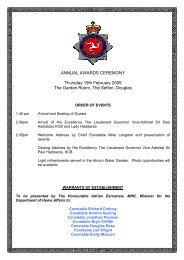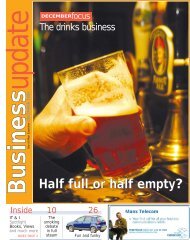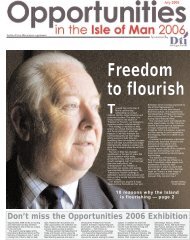m - Isle of Man Today
m - Isle of Man Today
m - Isle of Man Today
Create successful ePaper yourself
Turn your PDF publications into a flip-book with our unique Google optimized e-Paper software.
12<br />
m<br />
anxmillennium<br />
m<br />
anxmillennium<br />
13<br />
There are a limited<br />
number <strong>of</strong> cable car<br />
pictures and here we<br />
have a good one taken at the<br />
base <strong>of</strong> Victoria Street. In the<br />
background the magnificent<br />
Villiers Hotel as designed by<br />
Rennison the architect who<br />
came to the Island from<br />
Stockport. The cable cars<br />
worked on exactly the same<br />
principle as those in San<br />
Francisco and it was an urban<br />
form <strong>of</strong> transport. The route<br />
from the Jubilee Clock was up<br />
Victoria Street, Prospect Hill,<br />
Bucks Road, Woodbourne Road,<br />
York Road and them down<br />
Ballaquayle Road and Broadway<br />
to meet the promenade at the<br />
Villa Marina. The final decent<br />
was considered too dangerous<br />
and after a very short time the<br />
cars only went as far as Stanley<br />
View on Ballaquayle Road.<br />
MNH/pic/873<br />
I<br />
selected this lantern slide <strong>of</strong> a<br />
uniformed gentleman with a pier and<br />
lighthouse in the background<br />
because it presented a challenge. On the<br />
belt and knitted into the jumper are the<br />
initials R.V.L.C. and on his armband a<br />
crown. What did the initials stand for,<br />
what were the dates painted onto the<br />
slide and where was the pier. My initial<br />
thoughts were that the photograph was<br />
taken from the jetty at the end <strong>of</strong> East<br />
Quay in Peel and that the lighthouse was<br />
on the end <strong>of</strong> the Castle Jetty. Quite by<br />
accident when going through Constance<br />
Radcliffe’s excellent book ‘Shining by the<br />
Sea’ there was a photograph <strong>of</strong> a man<br />
standing by a wooden tripod used for<br />
‘breechers-buoy’ rescues, behind was a<br />
cart and all around was equipment for<br />
lifesaving. This view, which was possibly<br />
enlarged to show the lighthouse was in fact<br />
the top right hand corner <strong>of</strong> that on page 90<br />
<strong>of</strong> the book. From that I can tell you<br />
however that the man is Thomas Arthur<br />
Corlett an advocate and an <strong>of</strong>ficer <strong>of</strong> the<br />
Rocket Brigade in Ramsey. Formed in 1864<br />
it was entitled ‘Ramsey Volunteer Life<br />
Corps’. That explaind the initials. T. A.<br />
Corlett lived from 1851 to 1878 and I wonder<br />
if the dates on the slide related to the life <strong>of</strong><br />
the lighthouse. The south pier was raised in<br />
height in 1845 and a stone lighthouse added<br />
to replace a wooden one the same year. In<br />
the background is the ‘Abernathy’ part<br />
timber constructed extension to the North<br />
Pier <strong>of</strong> 1863-64. MNH/pic/470<br />
I<br />
had three views <strong>of</strong> this<br />
shipwreck from which to<br />
select one <strong>of</strong> the lantern<br />
slides for publication. I<br />
though this was the more<br />
dramatic even though one <strong>of</strong><br />
the others showed the ship<br />
before she began to break up.<br />
This slide was given to the<br />
<strong>Man</strong>x Museum in 1952 by<br />
Major F. C. Harris. The ship<br />
is the ‘Argo’ which was on<br />
passage from Bordeaux to<br />
Glasgow with a general<br />
cargo in December 1905. She<br />
struck the rocks at Meary<br />
Voar near Santon Head. The<br />
crew spent the night trapped<br />
on the vessel but the next<br />
day all fourteen were taken<br />
ashore. The heavy seas soon<br />
broke the ship into three<br />
MNH/pic/3729<br />
What a way to launch a<br />
lifeboat! Look closely<br />
and you will see there<br />
are two men on the boat as it<br />
is tipped into Ramsey<br />
harbour in this Midwood<br />
lantern slide. The first<br />
lifeboat house is believed to<br />
have been a wooden hut on<br />
land owned by the Harbour<br />
Commissioners, the arrival <strong>of</strong><br />
the ‘Two Sisters’ in 1868 saw<br />
the building <strong>of</strong> a stone lifeboat<br />
house a little north <strong>of</strong> the<br />
present building on the South<br />
Promenade. This was an ideal<br />
location for launching straight<br />
out on to the beach and in to<br />
the sea. In February 1895<br />
there was a blizzard as well as<br />
a heavy sea and a schooner<br />
had grounded on Ramsey<br />
beach close to the boathouse,<br />
It proved difficult to launch<br />
the lifeboat in the usual way<br />
and so she was hauled around<br />
onto the quayside where a<br />
lamp standard had to be taken<br />
down to facilitate the launch<br />
into the harbour. The lifeboat<br />
suffered damage to her bow<br />
which was quickly covered<br />
with a piece <strong>of</strong> tin but<br />
afterwards it was discovered<br />
that 13 planks were in fact<br />
damaged. This photograph is<br />
not however <strong>of</strong> that launch for<br />
there is no snow, no blizzard, no<br />
overcoats and something <strong>of</strong> a<br />
heat haze. So if this is after<br />
February 1895 why did they try<br />
it again after the damage the<br />
first time! The view was given<br />
to the <strong>Man</strong>x Museum in June<br />
1953 by Sam Bennett <strong>of</strong> Ramsey<br />
MNH/pic/3736

















